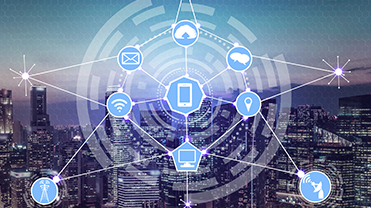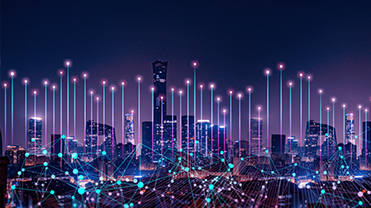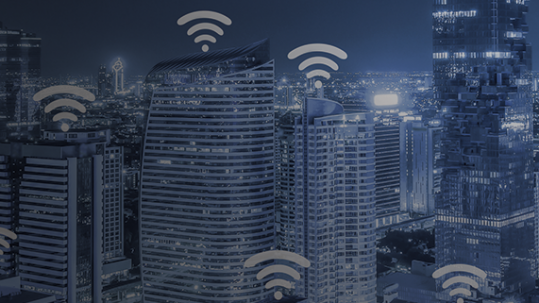digital buildings: the future of a
sustainable and connected world
In a world where technology is ubiquitous, digital buildings come as the next wave in this tech revolution. Constructs of modern architecture, engineering, along with advanced technologies like the Internet of Things (IoT), Artificial Intelligence (AI), and data analytics; digital buildings are interconnected spaces that are intelligent, efficient, sustainable, and responsive to the needs of their occupants. From reducing energy consumption and optimising space utilisation to enhancing occupant comfort and improving security, these buildings are transforming the way we live and operate. By harnessing the power of digital technology, smart buildings of today have become more than just static structures, instead morphing into dynamic entities that can adapt to changing circumstances and communicate with occupants to enhance their experience.
why the world needs digital buildings
energy conservation
One of the key benefits of digital buildings is their ability to save energy. An American Council for an Energy-Efficient Economy (ACEEE) report states that widespread adoption of digitalisation in buildings could cut energy usage by as much as 40%. By using sensors and automation technologies, smart buildings can adjust lighting, heating, and cooling systems to reduce energy usage and adapt to changing conditions. They can also use lighting control systems with advanced functionalities like daylight calibration and dimming to reduce electricity consumption. In the same vein, smart shades can analyse daylight and current weather conditions, and accordingly adjust the window shade movement to maximise use of natural light.
Furthermore, digital buildings can track energy usage data in real time, enabling facility managers to identify inefficiencies and implement targeted improvements. Embracing digital building technologies enables owners and operators to lower energy costs, decrease their carbon footprint, and improve the overall sustainability of their buildings.
data-driven insights
Information about various parameters from every system in a digital building — heating ventilation, and air conditioning (HVAC), lighting, and more — is collected and converted to a digital format on a real-time basis. Plumbing these massive amounts of data can provide real-time insights into how each system operates, which parts are lagging, which areas might need repairs in the future, and where can energy-saving methods be applied. Leveraging this data can change and improve processes and create buildings that operate more efficiently and safely.
enhanced productivity
Indoor heating, ventilation, and air conditioning (HVAC), lighting, and other critical functions significantly impact occupant health and safety. Studies reveal that maintaining humidity between 40% and 60% can reduce transmission of respiratory infections by around 70%. Improving ventilation by reducing CO2 levels can help circulate air safely; higher CO2 levels have been known to impair worker productivity by 11% and cause a 23% impairment in making decisions. Additionally, an International Labor Organization manual stated ‘smart’ lighting in factory buildings caused a 10% rise in productivity and a 30% decrease in human errors. Smart buildings that optimise all these functions are only increasing productivity and safeguarding the health of their occupants. The combination of IoT devices, personal computing devices, and integrated room-level automation can create a new built environment, one with happier, healthier, and more productive occupants.
predictive maintenance
Predictive maintenance in smart buildings is a proactive approach to facility management that leverages data from sensors, analytics, and machine learning to predict when equipment is likely to fail and schedule maintenance accordingly. By using real-time data to identify poten-tial issues before they cause equipment breakdowns, building owners and facility managers can reduce maintenance costs, extend the life of equipment, and minimise downtime. A study proved that such a data-first approach can reduce downtime by 35%, costs by 25%, and un-planned outages by 70%. Relying on predictive maintenance systems thus helps the building automation system (BAS) gain a more insightful overview of how the building is performing at all times.
Need an informed, data-driven approach to optimising your building’s energy consumption? Explore EdificeEdge, Softdel’s very own B-IoT gateway platform that unlocks ‘trapped’ data from a multitude of IoT devices, enabling you to utilise actionable insights for predictive and preventive maintenance.
security
Intelligent sensors, real-time monitoring systems, automated controls — these features make digital buildings a safer and more secure option than regular buildings, especially during emergencies. Unlike regular buildings, digital buildings have the capability to detect and prevent safety issues such as fires, gas leaks, and structural failures before they can escalate into serious incidents. Digital buildings can provide real-time access control and video surveillance to prevent unauthorised access, theft, or other criminal activities. Additionally, IoT devices can provide real-time data on occupancy levels, air quality, and other environmental factors that impact safety and comfort levels in the building. This data can be used to optimise building systems, such as heating, ventilation, and air conditioning (HVAC), and lighting, to ensure maximum safety and energy efficiency.
It’s not just IoT-led devices that can create a secure ecosystem for smart buildings, even communication protocols have their own safety measures to prevent cyber vulnerabilities, a problem that continues to plague the Internet of Things. For example, the BACnet protocol has a new datalink layer, the BACnet Secure Connect or BACnet/SC, which makes communications over a building automation network as secure as any financial transaction.
Want more security suggestions from the experts? Check out our blog on ‘IoT Device Security – 5 Key Measures For Device Manufacturers’.
reduced environmental Impact
New findings have emerged that indicate exactly why digital buildings are crucial to maintain environmental balance. According to the 2022 Global Status Report for Buildings and Construction, the building and construction sector together accounted for approximately 37% of CO2 emissions, a new high in our struggling world. Accelerating adoption of digital technologies in buildings can help us reverse this trend and hit the 2050 decarbonisation goal. Smart buildings are already doing a lot to ensure the building sector reduces their carbon footprint — data analytics makes sure essential resources like water and energy are allocated optimally, lighting and ventilation are automatically controlled to ensure indoor air quality, and waste and greenhouse gas emissions are greatly reduced. Digital buildings can also promote sustainable transportation through the implementation of electric vehicle charging stations and bike storage facilities, further moving the construction and built environment toward a sustainable future.
Digital buildings have transcended their traditional role as mere shelter and are now crucial in addressing emerging challenges related to safety, security, and sustainability. As our world becomes more connected, digital buildings will become essential to meeting the evolving needs of occupants, building owners, and society as a whole. They represent a significant step forward in building design and management and offer a glimpse into the future of sustainable, safe, and comfortable living and working environments.
See how Softdel’s Internet of Things solutions can help shape the digital buildings of tomorrow: https://www.softdel.com/digital-building-solutions/
Author
Pranav Phadatare, Senior Software Engineer







